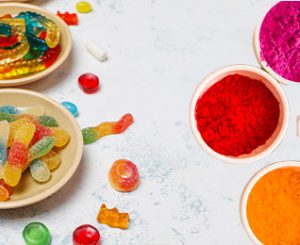Presentation is the key in the food industry...

Colour Psychology in Pharma Medicines
Medicine colors or pharmaceutical coloring agents or color additives are dyes and pigments that are added to pharmaceutical products like tablets and liquids during the manufacturing process along with other additives to give them a color.
Color additives are defined by the U.S. Food and Drug Administration as, “any pigment, dye, or other substance that can impart color to a drug, food, or cosmetic, or to the human body.”
While color additives don’t play any part in the effectiveness of the medicines as they are pharmacologically inactive substances, they do give the products their own identity. Colors are mainly used by the pharmaceutical industry to make the medicines more appealing for customers as well as impart the products with a specific appearance that can be easily identified by customers. E.g., A cherry-flavored pill that is red in color is much more appealing to anyone than a white-colored pill.
Till the mid-20th century, almost all pills were simply white and round, with almost no products having colors. The advent of colors in pharmaceuticals started around the 1960s and increased rapidly in the mid-1970s when softgel capsules were introduced. They came in primary colors then and now products are available in a vast variety of colors and color combinations.
Types Of Colors Being Used In Medicine
In the pharmaceutical industry, the most common colors used for pills and medicines are white, blue, red, yellow, green, and brown. But the types of colors used need to be known in greater detail, as there are different sources for colors as well as different types of colors.
- Color Additives Classified By Their Source
- Natural Colors: These coloring additives or agents are such that are sourced and produced from natural sources like plants, minerals, vegetables, animals, etc. There are 3 types:
- Colors Derived From Minerals: These are colors that are produced using mineral sources. For example, Titanium Oxide and Copper Sulfate.
- Colors Derived From Plants: These are colors that are produced using plants as sources. For example, Indigo, Turmeric, and Saffron.
- Colors Derived From Animals: These are colors that are produced using animal sources like insects. For example cochineal extract.
- Synthetic Colors: These colors are those that have been produced using chemical synthesizing, industrial means, or in laboratories. They have a higher intensity than natural colors when compared. For example, Patent Blue V, and Carmoisine.
- Color Additives Classified By Their Solubility
- Dyes: Dyes are coloring agents that are soluble in water. They chemically bond to the substrate to which they are being applied. They are mostly organic compounds. For example, Quinoline Yellow and Allura Red.
- Pigments: Pigments are coloring agents that are insoluble in water. They need a binding agent to adhere to a substrate. They are mostly inorganic compounds. For example, Red Ferric Oxide and Beta-Carotene.
- Lakes: Lake colors or lake pigments are water-insoluble types of synthetic water-soluble dyes which means that they are insoluble in nature. They color through dispersion. Lakes are produced through the precipitation of soluble dyes with some metallic salt. For example, Aluminium lakes.
Importance Of Colors In Medicine
Colors hold a very important place in pharmaceuticals even though they have no use in the effectiveness of medicines. Their contribution is more psychological. Let us understand their importance:
- They provide tablets, pills, liquids, and other products with their own brands, identities, and the ability to be easily identifiable and recognizable by consumers.
- Adding a coating of color gives many products more stability and hence helps to increase their shelf life.
- Due to branding, advertising, and marketing, products are associated with their colors and hence can be immediately identified simply by their color (E.g., Digene has a unique light pink color). This helps consumers differentiate between real products and counterfeits.
- It is scientifically proven that people also eat with their eyes, thus, having an orange-flavoured pill that is also orange in color makes it more appealing for consumers to consume the product.
- Colors can also help differentiate between dosages. i.e., if the same pill comes in different intensities, having them be different colors will prevent overdosing.
Utility
Color additives and pharmaceutical colors have many different uses as they are used for many other things other than coloring medicines. They are also used by other businesses like Natural food color exporters and Inorganic pigment powder exporters.
Coloring agents are used to add or impart color onto and into cosmetic products, toiletries, foods, clothes, and more.
They are produced by different businesses like Natural food color manufacturers, Inorganic pigment powder manufacturers, Lake color manufacturers, Acid dyes manufacturers, and Fast base manufacturers.
Saujanya Exports is a manufacturer and exporter of natural food colors, synthetic food colors, dyes, pigments, and more. We believe in providing high-quality but cost-effective products. We also provide our products in bulk.







